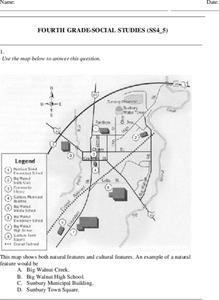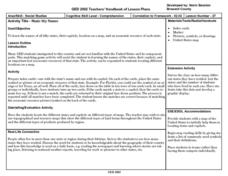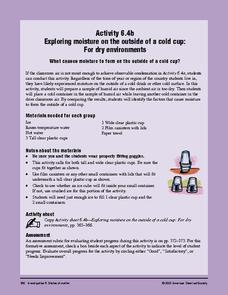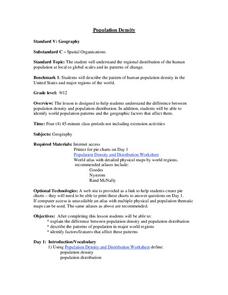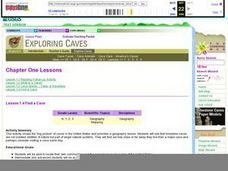Curated OER
Fourth Grade Social Studies
In this social studies worksheet, 4th graders answer multiple choice questions on state maps, city maps, road maps, political maps, and more. Students complete 25 multiple choice questions.
Curated OER
The Crisis in Darfur
Students examine the history and current humanitarian crisis occurring in the Darfur region of Sudan. In small groups, they conduct Internet research, answer discussion questions, and present their findings to the class.
Curated OER
State My Name
Students study the names of all fifty states, their capitols, location on a map, and an economic resource of each state. They complete a matching game activity.
Curated OER
A Nation of Nations Lesson Plan: Charting African Ethnicities in America
High schoolers read a portion of the narrative, The Transatlantic Slave Trade, to explain the ethnic origins of enslaved Africans brought to the US. They create charts and bar graphs comparing ethnicities in the lowlands and tidewater...
Curated OER
In the Footsteps of West Virginia
Students prepare for a visit to the West Virginia State Museum. In this West Virginia history lesson, students research the individuals whose leadership impacted the state. Students create multimedia projects featuring the individuals...
Curated OER
Social Studies: Geographic Regions
Third graders create Powerpoint presentations about the five themes of geography in regions of the United States. They focus on the Northeast, Southeast, and Midwest regions. Students use both pictures and words in their shows.
Curated OER
The Hartford Convention and the Battle of New Orleans
In this United States history worksheet, students utilize a word bank of 10 terms or phrases to answer 10 fill in the blank questions about the Hartford Convention and the Battle of New Orleans. A short answer question is included as well.
Cornell University
Insect Anatomy
Young entomologists discover insect anatomy in a very detailed unit plan. Offering background information for teachers about various insects, class members explore the differences between bugs and insects—and yes, there are many...
Smithsonian Institution
African American Music: Let’s Sing and Play Clapping Games
Two lessons focus on making a beat. Using popular African American music of its time, scholars listen and analyze the rhythm then recreate it with hands drums, and cups.
Curated OER
It's a Gas! Or is it?
Oceanography enthusiasts are given a series of thought experiments to consider in order to relate the solubility of gases and solids to underwater volcanoes. It is not particularly engaging to perform these thought experiments. Choose...
iCivics
County Basics
To understand the concept of a county government system, scholars read a short passage, view a helpful visual aid, use the web to conduct some research about their local areas, and then answer related questions online.
Curated OER
How Big is Big?
Geography learners compare and contrast population densities throughout the world. Using maps, they estimate the relative size of the world's regions and populations. They develop analogies to discover the world they live in and...
American Chemical Society
Exploring Moisture on the Outside of a Cold Cup: For Dry Environments
If the area you live in is arid, or the preceding experiment in this unit didn't yield obvious results, use this one in place of it to help reveal where condensation comes from. The mini unit that this is part of a comprehensive...
Curated OER
Virtual Vacation
Learners are members of teams traveling and exploring the Pacific States Region of the United States via the Internet. Each team travels virtually to its destination to become experts on geography, history, tourism, nature, and economics.
Curated OER
U.S. and Canada: How are We the Same? How are We Different?
Get high school geographers to compare and contrast Canada and the United States. They begin by drawing a freehand map of North America, then complete readings to gain insight into Canada. The text is not provided; however, another text...
Curated OER
Canada, O Canada
Students study the similarities and differences between Canada and the United State in this unit. They examine geography, government and culture as they "travel" through Canada.
Curated OER
Population Density
Students examine world population density and population distribution. They create pie charts showing population distribution and analyze population patterns in the United States and major regions of the world. They identify...
Curated OER
Find a Cave
Students locate their own communites and the nearest caves on a United States map. They calculate the distance to the nearest cave using rough scale.
Curated OER
California Artists
Fifth graders identify and compare works of art from various regions of the United States. Telecollaborative partners, from different states, work together to complete this assignment. Using the internet, 5th graders research a specific...
Curated OER
East Asia & The World
Students discuss the relationships between East Asia and the United States. They examine the importance of trade and politics. They examine graphs and charts of certain aspects of the region and discuss.
Curated OER
Recognizing How Another Culture Differs From One's Own
Students determine what it means to be on time. In this cultural comparisons lesson, students compare the notion of punctuality between the United States and Guinea. Students read "Being on Time," by Kimberly Ross and discuss the...
Curated OER
Harvest Seasons Mobile
Students discuss the types of crops that are grown in different regions of the United States. Using given steps, students create a mobile to depicting crops that are harvested in specific seasons of the year. Mobiles are gathered and...
Curated OER
An International Dinner Table
Students investigate the origins of several crops eaten in the United States today. The facto0rs that influence consumer choices and the influences on the American population as to eating preferences are discussed in this lesson.
Curated OER
Images of Our People
Students investigate the history of peoples in the western United States. To accomplish this Students use photographs as images that capture the context of different cultures. Then they write reflections about each culture.


